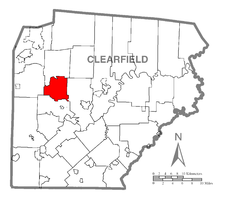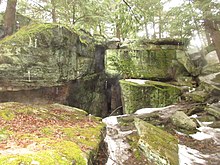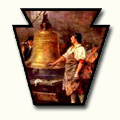.jpg)
.jpg)
Clearfield County PAGenWeb
Bloom Township History
Named for a pioneer family, Bloom
History of Clearfiled County, Pennsylvania: with illustrations and biographical sketches of some of its prominent men and pioneers by Lewis Cass Aldrich Syracuse, N.Y.: D. Mason, 1887, pp. 428-434.
CHAPTER XXVI.
HISTORY OF BLOOM TOWNSHIP.
THIS township was named " Bloom " in honor of one of the pioneer families of the county that has been, perhaps, more prolific than any other in the county, the descendants of William Bloom being counted by the hundreds, and being now scattered through several of the townships of the county.
Bloom township was erected upon the petition of divers inhabitants then residents of the several townships of Penn, Pike, Brady and Union. This petition was presented to the Quarter Sessions Court held in the month of August, 1857, and by an order then made John L. Cuttle, Ellis Irwin and James T. Leonard were appointed commissioners to view the premises and make the division necessary for the new erection. By their report the commissioners laid out the new township as follows : Beginning at the northwest corner of tract No. 3,581, thence east by tracts Nos. 3,581 and 3,573, 416 perches to a corner; thence south to old hemlock, the northwest corner of tract No. 3,608; thence east 832 perches, by tracts Nos. 3,608 and 3,579, to a corner; thence south by No. 3,579 to corner of 4,020; thence east by tract 4,020, 183 perches to maple ; thence south by No. 4,020, land of Josiah W. Smith, to the southwest corner of tract No. 5,781 ; thence east by land of Susanna Irwin and J. F. Irwin, to an old birch; thence south by land of J. F. Irwin and John Thomas, to the northeast corner of a forty acre lot of John P. Dale's ; thence west to the corner of J. P. Dale's lot ; thence south by said lot to a corner, east perches to a corner, and south to the southwest corner of said Dale's lot to tract line ; thence west to corner between Moore's land and land of Fenton and Spencer ; thence northwesterly between said lands to a corner on line of John Bilger ; thence west by lands of Charles C. Case and William Wood to the Big Run ; thence up the Big Run to tract line of number 2,004 ; thence west 360 perches, more or less, to the southwest corner of number 2,004, thence north to a hundred acre lot out of four tracts at the corner of number 2,004, west to a corner of said lot, north by said hundred acre lot to the corner, and east by said lot to old tract line, and thence north by old tract line to place of beginning.
In the month of October following this order was made : " The court orders a vote of the qualified electors of the township from which the largest number of taxables to be embraced in the proposed new township is to be taken ; and also of the qualified electors outside of each township residing within the bounds of the proposed new township, to be taken, and fix the first Saturday in November next as the time at which the vote is to be taken ; and the constable of the township from which the largest number of votes is to be taken, is ordered to give fifteen days' notice of said election by at least six written or printed advertisements, to be put up in the most public places in said township." The return made by the officers of this election was as follows : " We, the judges and inspectors of an election held at the house of Isaac Bloom, in the borough of Curwensville, the election house of Pike township, on the 5th day of November, 1859, as ordered by the court of Quarter Sessions, in reference to the erection of a new township out of parts of Pike, Penn, Brady and Union townships, do certify that upon closing the polls and counting the votes, there was for the new township eighty-seven ; against, none. Signed, John Smith, Judge ; John Norris, M. L. C. Evans, Inspectors ; G. W. McDowell and Hiram Leech, Clerks."
The formation of the new township was completed by the following order of the court: "And now on the 14th day of January, 1860, the new township is erected to be called ' Bloom ' ; the public house of James Bloom is designated as the place at which elections shall be held." George Leech was appointed judge, and John Smith and Robert Neeper, inspectors to hold the first election, to take place at the usual day, in February, 1860, at which the elections are held in the county. The various offices of the township were filled at the first election, as follows : Justices of the peace, John Smith and Samuel Irvin; constable, James Bloom ; judge of elections, Andrew Rummer; inspectors, Hugh Leech and Gainor Bloom; supervisors, Levi Draucker and Samuel Irvin; school directors, John Irvin, John Macklin, Charles Cleaver, Charles Goff, John Smith and David Chilson ; overseers, James Bloom and Charles Cleaver ; auditors, Thomas Cleaver, Algernon Holden and George Irvin ; assessor, George Leech ; town clerk, Robert Taylor.
Bloom township, therefore, was formerly a part of the still older Pike, Penn, Brady and Union, and its early history is told by the settlement of those townships of which it originally formed a part; in fact, the whole of its territory and the other townships on this side of the Susquehanna, as well, were in the year 1813 erected into Pike. Prior to that they were a part of the original formation known as Chincleclamoose, or more properly using the Indian pronunciation, Chincleclamousche. The boundary lines of the township on the west, north and east are comparatively regular, while the south line is decidedly irregular and broken, evidently so run for the purpose of including or excluding certain tracts of land within or from the new formation. The township is bounded on the north by Union, east by Pike, south by Penn and west by Brady township. Its surface is generally hilly and mountainous. The stream Anderson Creek flows in a direction generally southeast through the eastern and northeastern part of the township. Tributary to this and having its course through the northern portion of the township is Little Anderson Creek. The settlement of this section of the country was not, of course, as early as that in the parts less remote from the river. Settlement is gradual, even slow, and lying to the north several miles from the Grampian Hills, and in a dense forest, it was not until a score or more of years that the sturdy pioneer ventured away from the accustomed haunts and habitations of the then new country into a region so desolate and uninviting.
The first efforts toward settlement and cultivation in this locality were made about the years 1814 and 1815, and were hastened somewhat by the incorporation and construction of the Susquehanna and Waterford pike, the line of which lay through the township.
One of the first families to settle in this locality was that of Isaac Rodden, a former resident of Centre county. He came to Bloom township while it formed a part of Pike, about the year 1815, and settled on lands along the line of the turnpike. His children were George, who died young; Rachel, who married Daniel Barrett, father of Judge George Rodden Barrett ; Eliza, who married Josiah Evans, of Curwensville; Keziah, who became the wife of William Carson, of Centre county, and Anna, who married Jonathan Evans, brother of Josiah Evans. Isaac Rodden died half a century or more ago. He was a peculiar person, yet possessed of many fine traits of character. His business transactions, though not numerous, were conducted with due ceremony, especially so when Joseph Boone was concerned in them. A day would be set apart for their consummation after all the preliminaries had been settled. Henry Boone came along to act as an amanuensis. After writing for a time the papers were laid aside and a very fine article of refreshment passed around, (By the way, Isaac Rodden became quite famous for having the best brands obtainable). After due consideration of the immediate subject, business was resumed, and thus alternating, the whole day was passed, Boone being frequently constrained to remain over night.
George Rodden Barrett, who later in life became Judge Barrett, lived in the family of Isaac Rodden from the age of eight to fifteen years. There is not now residing in the entire county a single family bearing the surname of Rodden, the son, George, having died before reaching his majority.
James Bloom, or as he afterward became known, Judge Bloom, son of William Bloom, one of the pioneers of Pike, took up his residence in this locality at an early day. He married Mary Passmore, daughter of Abram Passmore, and raised a family of several children. Among these children were William M., the auctioneer at public sales, and a blacksmith by occupation, residing at Bloomington ; Emily, who married Anthony Hile of Lumber City; Elizabeth, who became the wife of Stacy W. Thompson, residing in the State of Michigan ; Abram P., of Pike; Lewis I., now residing on the old homestead farm in Pike, and who enjoys local celebrity as a veterinary surgeon ; Gainor P., residing near Pennville; Martha, who married Franklin Averill, of Bloom township ; Jemima, who united in marriage with John Dunlap, of Knox township, and Susanna, who married Algernon Holden, of Bloom township.
James Bloom occupied a prominent position in the affairs of the township and was elevated to the office of associate judge of the county. He was for a long time proprietor of the hotel on the " pike " known as the " Forest House." At this place was a post-office station and Mr. Bloom was postmaster. The hotel at Forest was built by Alexander Cook, whom Judge Bloom succeeded in its management.
Jonathan Taylor was another of the pioneers of the township. He came from Centre county soon after Isaac Rodden. In fact a majority of these pioneers were former residents of Centre county and came to this locality through the influence of Mr. Rodden. Taylor lived on the site on which the Forest House was built. He was a blacksmith by trade, and had a large family.
James McWilliams, a man of large family, but few of whom are now living, came about the same time. He lived about a mile south of the Forest hotel, and on the road leading to Pennville and the Grampian Hills. McWilliams was an inveterate hunter, and kept a number of dogs of various kinds as well as a complete assortment of hunting equipments.
John Ellinger moved into the eastern part of the township from Brady. He had a large family and is yet living at an advanced age.
The Henry family were among the pioneers. But few of the descendants are now living, having moved to other parts and many of them have died.
On the farm now owned and occupied by Henry Reams was located the town known for many years as Packersville, so called by Isaac Packer, a person of some note and prominence during the early days of the region. Packer was a native Pennsylvanian. He built a hotel on this place and made it a favorite resort on the pike, although it possessed but few of the elements that make comfortable public houses. Of the town of Packersville but little can be said and all evidences of it are removed. The hotel was torn down some ten years ago by Mr. Reams. After Packer sold it was kept for a time by John Neeper.
The turnpike, to which frequent reference has been made, was the Susquehanna and Waterford Turnpike road, incorporated in 1818. The line of this road lay through the township, but it was not long in use, being superseded by others.
The town of Packersville became prominent by being mentioned in connection with the turnpike company incorporated in the year 1828, and known as the Snow Shoe and Packersville turnpike, the incorporators of which were Thomas Hemphill, John Kyler, Reuben Winslow, Philip Antes, jr., Lebbeus Luther, William Alexander, Thomas Burnside, John Rankin and Robert Lisston. The line of this road commenced at or near Snow Shoe, on the Milesburg and Smethport turnpike road, in Centre county, thence through Clearfield town to the Erie turnpike road at or near Packersville.
The present main thoroughfare through the township is the Cream Hill turnpike road, the general course of which is east and west. This is about the only toll-road now operated in the county.
The early settlement of Bloom was confined mainly to the line of the roads, but as these lands were occupied new-comers were compelled to branch out more into the then unoccupied portions, but to this day the upper or northern part of the township is but sparsely settled, except along the course of the streams.
As is stated in the early part of this chapter, George Leech was elected assessor at the February election in the year i860. In his list of taxables made in 1861, the following names appear : Samuel Arnold, assessed as having a saw-mill, transferred from James M. Welch & Company. Samuel Arnold, however, was not a resident of the township. George A. Bloom, James Bloom, sen., John Bilger, Jacob Bilger, John Bridge, Gainor Bloom, Henry Bickel, Cyrus Blackburn, Titus Bailey, Thomas Cleaver, jr., Charles Cleaver Thomas Cleaver, sen., David Chilson, John W. Cleaver, Wilham Derrick, Aaron Dun worth, Levi Draucker, Valentine Dale, John Ellinger, Samuel George, Charles Goff, William Henry, Algernon Holden, George and Jacob Hess, George W., and Wesley Horn, David Henry, William, Samuel, George, Eliza and Matilda Irwin, Reuben R. Johnson, O. D. Kendall, Adam Korb, H. C, George, sen., James, Robert and George Leech, Erastus Luther, William Lines, Silas Munn, Francis McBride, Ezra Moore, John Mclntyre, Henry Marshall, John McLinn, Robert Neeper, William McNaul, Andrew and Henry Pentz, Tobias Shaffer, Henry Sykes, John Smith, Theodore Stevens, Andrew Rummer, John Thomas, Stacy and Simon Thompson, George Weaver, James M. Welch & Co., Isaac Woods, Lewis Woods, Joseph Whitmore, Adam Weaver, Jacob Zilliox. The single freemen of the township were as follows: George W. Leech, Robert Leech, William Henry, Henry Bickel, George Irwin, Samuel Irwin, Zachariah Bailey, William Toy, George Hess, Henry Stugart, Calvin Jackson, Alonzo D. Miller, John Stevens, W. W. Fargo, Ambrose Spencer, Edward Husman, Albert S. Varny, W. M. Runkman.
There were in the township at the time this assessment was made, several saw-mills, owned as follows: Samuel Arnold, formerly James M. Welch & Co., Jacob Bilger, John Bridge, Wesley Horn, Reuben R. Johnson, and Silas Munn.
In addition to the enrollment of taxables, the assessor also prepared a list of the persons of the township that were subject to military duty, and known as militia men. They were: John Bilger, Gainor Bloom, Henry Bickel, Charles Cleaver, Thomas Cleaver, David Chilson, John W. Cleaver, William Derrick, Levi Draucker, Valentine Dale, Charles Goff, William Henry, George Hess, Jacob Hess, Reuben R. Johnson, William Irwin, O. D. Kendall, Hugh C. Leech, James Leech, Robert Leech, George W. Leech, Erastus Luther, Andrew Rummer, Franklin McBride, Henry S. Marshall, William Lans, John McLinn, Tobias Shaffer, John Smith, Theodore Stephens, George Weaver, Isaac Woods, Levi Woods, Joseph Whitmore, Adam Weaver, Jacob Zilliox. From the time the first list of taxables was made to the present, there has been but very little increase, the roll for the year 1886 showing only one hundred and ten.
There is not now within the township a mercantile business, a saw-mill, or postal station, that at Forest having been discontinued a few years ago. Neither is there within the township at present any church edifice, that of the Methodist Protestant society having been destroyed by fire about three years since. From this it must not be inferred that the inhabitants of the township are at all neglectful of their spiritual welfare and comfort, on the contrary several societies are in existence, but neither of them sufficiently strong, numerically, to afford the erection of a church edifice.
The society of the Methodist Episcopal church was organized some thirty years ago, with Henry Reams as class-leader. Their meetings have been held mainly in the Chestnut Grove school-house, but an effort is now making looking to the erection of a house of worship, the site for which has already been secured. This society numbers about thirty persons, prominent among whom may be mentioned the Reams family, Squire Smith and wife, Joseph Whitmore, wife and children, William Henry and wife, and others.
The Methodist Protestant church society held their early meetings in the school- house known as the " Greenville " school, but they gained sufficiently in strength, and were able to erect a comfortable house of worship on the turnpike in the eastern part of the township, and near the school building. This church edifice, a frame building, was destroyed by an incendiary fire about three years ago, and has not since been rebuilt. The society has decreased in numbers, some having drifted into other societies. Among the residents of the locality who have been active in the affairs of this society, were the families of James Cleary. He was the leading member, and for a time officiated as local preacher. To him is due the credit of having gathered together the funds for the building of the church edifice. Other members were : John Ellinger, John Bilger, Isaac Thompson, also a local preacher ; George Leech and wife, and others as well.
Besides these there have been other societies in the township, of greater or less strength, but whose efforts have not been sufficiently successful to warrant a house of worship. Their meetings have been held at such places as were most convenient, mainly in school-houses, and have partaken more of the character of missionary labors in an effort to establish a society. Of the societies thus laboring have been those of the United Brethren, the Baptists, and that commonly known as the Dunkards.
In affairs pertaining to education, Bloom township is as well provided for as any other of the townships of the county in proportion to population or needs, there being at the present time three well appointed schools, as follows: One at Greenville, in the eastern part, taught by T. J. Widemire ; one at Chestnut Grove, taught by T. L. Wall, and the third in the Goff neighborhood, taught by R. P. Kester. The names here given as such as have been used by the residents of the township in order to distinguish particular localities. At the township election held in the month of February, 1887, the following officers were elected : Justice of the peace, C. A. Wood; constable, Milton Smith ; assessor, Isaac Wood ; judge of election, Isaac Bloom ; inspectors, Green Henry, and Isaac Thomas ; clerk, G. M. Henry ; school directors, Rodney Charles, A. S. Holden, Gilbert Thomas, L. E. Laborde ; auditor. Christopher Hatsfelt ; supervisors, George R. Bloom, R. E. Elder ; collector, George Korb ; overseer, Tobias Korb.


Bilger's Rocks
Bilger's Rocks is a park in Clearfield County, Pennsylvania, USA, near the town of Grampian in Bloom Township. The surrounding area is intricately laced with hills, mountains, and river valleys that generally follow the Appalachian mountain range in a northwest to southeast direction. The area of the park is located along the Allegheny section of the mountains, approximately 8 miles (13 km) southwest of the highest point on Interstate 80 east of the Mississippi River.
Bloom
Chestnut Grove
Glendale
Greenville
Laborde
Packersville



